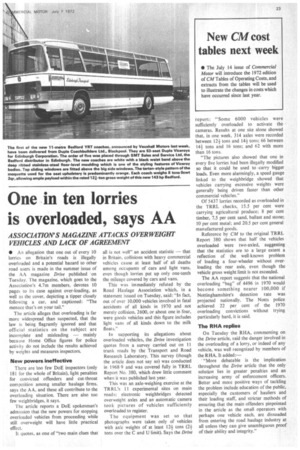One in ten lorries is overloaded, says AA
Page 25

If you've noticed an error in this article please click here to report it so we can fix it.
ASSOCIATIOIV'S MAGAZINE ATTACKS OVERWEIGHT VEHICLES AND LACK OF AGREEMENT
• An allegation that one out of every 10 lorries on Britain's roads is illegally overloaded and a potential hazard to other road users is made in the summer issue of the AA magazine Drive published on Tuesday. The magazine, which goes to the Association's 4.7m members, devotes 10 pages to its case against over-loading, as well as the cover, depicting a tipper closely following a car, and captioned: "The menace that's on your tail."
The article alleges that overloading is far more widespread than suspected, that the law is being flagrantly ignored and that official statistics on the subject are incomplete and misleading --mainly because Home Office figures for police activity do not include the results achieved by weights and measures inspectors.
New powers ineffective
There are loo few DoE inspectors (only 181 for the whole of Britain), light penalties for convicted offenders and cut-throat competition among smaller haulage firms. says the AA, and these all contribute to the overloading situation. There are also too few weighbridges, it says.
The article reports a DoE spokesman's admission that the new powers for stopping overloaded vehicles from proceeding while still overweight will have little practical effect.
It quotes, as one of "two main clues that all is not well" an accident statistic — that in Britain, collisions with heavy commercial vehicles cause at least half of all deaths among occupants of cars and light vans, even though lorries put up only one-tenth the mileage covered by cars and vans.
This was immediately refuted by the Road Haulage Association which, in a statement issued on Tuesday, said: "In fact, out of over 10,000 vehicles involved in fatal accidents of all kinds in 1970 and not merely collision, 2600, or about one in four, were goods vehicles and this figure includes light vans of all kinds down to the milk floats."
In supporting its allegations about overloaded vehicles, the Drive investigation quotes from a survey carried out on 11 trunk roads by the Transport and Road Research Laboratory. This survey (though the article does not say so) was conducted in 1968-9 and was covered fully in TRRL Report No. 380, which drew little comment when it was published last year.
This was an axle-weighing exercise at the TRRL's 11 experimental sites on main roads; electronic weighbridges detected overweight axles and an automatic camera took pictures of vehicles sufficiently overloaded to register.
The equipment was set so that photographs were taken only of vehicles with axle weights of at least 12+ tons (2+
tons over the C and U Says the Drive
report: "Some 6000 vehicles were sufficiently overloaded to activate the cameras. Results at one site alone showed that, in one week, 314 axles were recorded between 12+ tons and 14+ tons; 66 between 14+ tons and 16 tons; and 62 with more than 16 tons.
"The pictures also showed that one in every five lorries had been illegally modified so that it could be used to carry bigger loads. Even more alarmingly, a speed gauge linked to the weighbridge showed that vehicles carrying excessive weights were generally being driven faster than other commercial vehicles."
Of 5437 lorries recorded as overloaded in the TRRL checks, 15.5 per cent were carrying agricultural produce; 8 per cent timber, 7.5 per cent sand, ballast and stone; 10 per cent metal; and 20.5 per cent general manufactured goods.
Reference by CM to the original TRRL Report 380 shows that half the vehicles overloaded were two-ax led, suggesting that the statistics are to a large extent a reflection of the well-known problem of loading a four-wheeler without overloading the rear axle, even though the vehicle gross weight limit is not exceeded.
The AA report suggests that the national overloading "bag" of 4496 in 1970 would become something nearer 100,000 if Nottinghamshire's detection rate was projected nationally. The Notts police achieved 22 per cent of the 1970 overloading convictions without trying particularly hard, it is said.
The RHA replies
On Tuesday the RHA, commenting on the Drive article, said the danger involved in the overloading of a lorry, or indeed of any vehicle, was well recognized by members of the RHA. It added:— "More debatable is the implication throughout the Drive article that the only solution lies in greater penalties and an increasing army of enforcement officers. Better and mote positive ways of tackling the problem include education of the public, especially the customers of hauliers and their loading staff, and stricter methods of ensuring that the main offenders pinpointed in the article as the small operators with perhaps one vehicle each, are dissuaded from entering the road haulage industry at all unless they can give unambiguous proof of their ability and integrity."
















































































































































